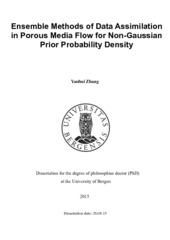| dc.contributor.author | Zhang, Yanhui | eng |
| dc.date.accessioned | 2015-10-28T09:44:15Z | |
| dc.date.available | 2015-10-28T09:44:15Z | |
| dc.date.issued | 2015-08-28 | |
| dc.identifier.uri | https://hdl.handle.net/1956/10607 | |
| dc.description.abstract | Ensemble-based data-assimilation methods have gained fast growth since the ensemble Kalman filter (EnKF) was introduced into the petroleum engineering. Many techniques have been developed to overcome the inherent disadvantages of the ensemble-based methods including the assumptions of linearity and Gaussianity, to make it more robust and reliable for practical reservoir applications. The current trend in petroleum reservoir history matching is towards taking into account more realistic reservoir models with complex geology. Geologic facies modeling plays an important role in the reservoir characterization as a way to reproduce important patterns of heterogeneity in petroleum reservoirs and to facilitate the modeling of petrophysical properties of reservoir rocks. Because the static data and general geological knowledge are almost always not sufficient to determine the distribution of geologic facies uniquely, it is advantageous to assimilate dynamic data to reduce the uncertainty. The history-matching problem of geologic facies involves large nonlinearity and non-Gaussianity. When the ensemble Kalman filter (EnKF) or related ensemble-based methods are used to assimilate data in a straightforward way, the updated model variables would lose the geological realism and be contaminated with noise. Therefore, it is necessary to develop some effective measures to adapt the ensemble-based dataassimilation methods to the facies problems. This thesis is motivated by this necessity and explores the ways to conditioning geologic facies to production data using ensemble-based methods. The focus is placed on the post-processing approach. By modifying the standard randomized maximum likelihood algorithm to accommodate non-Gaussian problems, we introduce a methodology that consists of a straightforward implementation of ensemble-based data assimilation in the first place and a sequential optimization procedure without iteration as a follow-up. In a similar manner, we develop another method for the post-processing of the updated reservoir models after data assimilation using ensemble-based methods. In the post-processing step, the objective function is composed of a weighted quadratic term measuring the distance to the posterior realizations, and a penalty term forcing model variables to take discrete values. A special emphasis is put on the investigation of the importance of the correlation information among the updated model variables introduced by the data which is usually ignored for the probability map approach. All of the proposed methodologies are evaluated via numerical experiments and demonstrated their utilities for improving the assimilation of data to geological facies models. In this thesis, we also investigate the application of discrete curvelet transform in the denoising problem of updated model variables by the direct use of ensemble-based data-assimilation methods. According to the numerical experiments, the results show that curvelets are useful for denoising in the problem concerned but lose data match unless the covariance is included. | en_US |
| dc.language.iso | eng | eng |
| dc.publisher | The University of Bergen | en_US |
| dc.relation.haspart | Paper I: Yanhui Zhang, Dean S. Oliver, Yan Chen and Hans J. Skaug, Data assimilation using the EnKF for 2-D Markov chain models, in Proceedings of the 13th European Conference on the Mathematics of Oil Recovery (ECMOR XIII), Biarritz, France, 10-13 September 2012. Full text not available in BORA due to publisher restrictions. The article is available at: <a href="http://dx.doi.org/10.3997/2214-4609.20143179" target="blank">http://dx.doi.org/10.3997/2214-4609.20143179</a> | en_US |
| dc.relation.haspart | Paper II: Yanhui Zhang, Dean S. Oliver, Yan Chen and Hans J. Skaug, Data assimilation by use of the iterative ensemble smoother for 2D facies models, SPE Journal, 20 (01): 169-185, SPE-170248-PA, 2014. Full text not available in BORA due to publisher restrictions. The article is available at: <a href="http://dx.doi.org/10.2118/170248-PA" target="blank">http://dx.doi.org/10.2118/170248-PA</a> | en_US |
| dc.relation.haspart | Paper III: Yanhui Zhang, Dean S. Oliver and Yan Chen, Beyond the probability map: representation of posterior facies probability, in Proceedings of the 14th European Conference on the Mathematics of Oil Recovery (ECMOR XIV), Catania, Sicily, Italy, 8-11 September 2014. Full text not available in BORA due to publisher restrictions. The article is available at: <a href="http://dx.doi.org/10.3997/2214-4609.20141784 " target="blank">http://dx.doi.org/10.3997/2214-4609.20141784</a> | en_US |
| dc.relation.haspart | Paper IV: Yanhui Zhang, Dean S. Oliver, Hervé Chauris and Daniela Donno, Ensemblebased data assimilation with curvelet regularization, Journal of Petroleum Science and Engineering, 2015. Full text not available in BORA due to publisher restrictions. The article is available at: <a href="http://dx.doi.org/10.1016/j.petrol.2015.10.026" target="blank">http://dx.doi.org/10.1016/j.petrol.2015.10.026</a> | en_US |
| dc.title | Ensemble Methods of Data Assimilation in Porous Media Flow for Non-Gaussian Prior Probability Density | en_US |
| dc.type | Doctoral thesis | |
| dc.rights.holder | Copyright the Author. All rights reserved | en_US |
| dc.subject.nsi | VDP::Matematikk og Naturvitenskap: 400::Matematikk: 410 | en_US |
